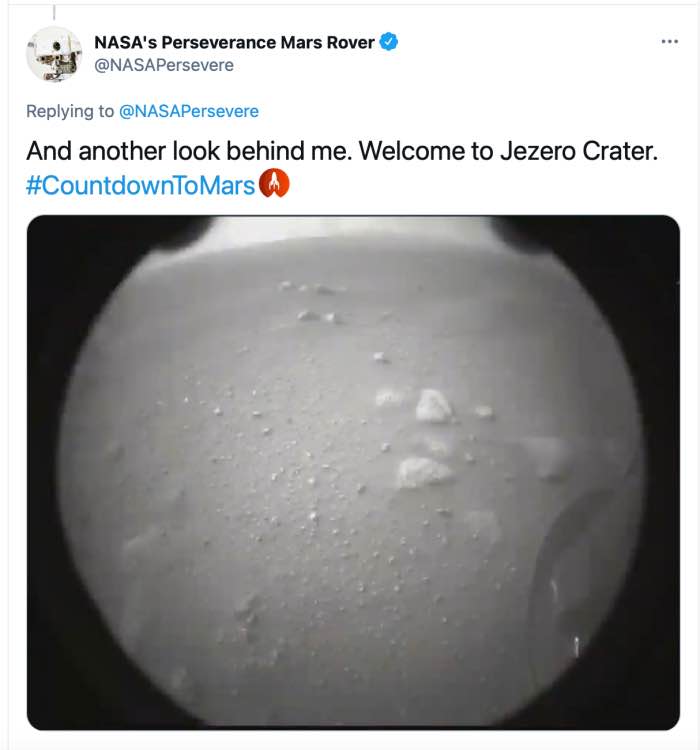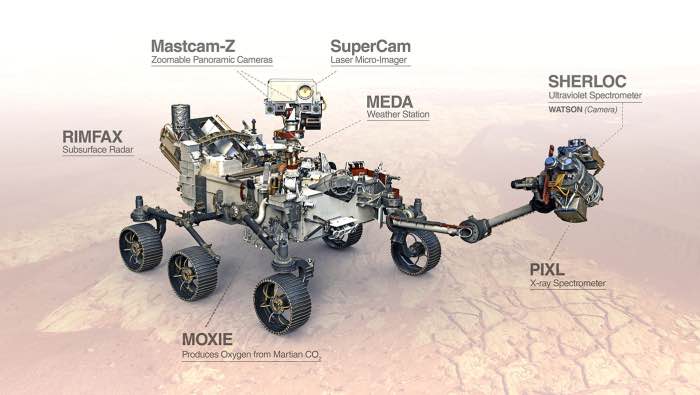NASA has done it. After a 203-day journey traversing 472 million kilometers, Perseverance rover, the U.S space agency’s largest and most advanced rover sent to another world, has finally touched down on Mars. The confirmation of the successful touchdown was announced in mission control at NASA’s Jet Propulsion Laboratory in Southern California on Thursday. The journey took around seven months in space. Packed with groundbreaking technology, the Mars 2020 mission was launched on July 30, 2020, from Cape Canaveral Space Force Station in Florida. National Aeronautics and Space Administration’s (NASA) Perseverance rover mission marks an ambitious first step in the effort to collect Mars samples and return them to Earth.
Perseverance rover, the robotic geologist and astrobiologist about the size of a car weighing 1,026-kilogram, will undergo several weeks of testing before it begins its two-year science investigation of Mars’ Jezero Crater. While the rover will investigate the rock and sediment of Jezero’s ancient lakebed and river delta to characterize the region’s geology and past climate, a fundamental part of its mission is astrobiology, including the search for signs of ancient microbial life.
The Mars Sample Return campaign, being planned by NASA and ESA (European Space Agency), will allow scientists on Earth to study samples collected by Perseverance to search for definitive signs of past life using instruments too large and complex to send to the Red Planet.
“Perseverance is the first step in bringing back rock and regolith from Mars. We don’t know what these pristine samples from Mars will tell us. But what they could tell us is monumental – including that life might have once existed beyond Earth,” said Thomas Zurbuchen, associate administrator for science at NASA.
Jezero Crater: Where Perseverance rover touched down on Red planet
Some 45 kilometers wide, Jezero Crater sits on the western edge of Isidis Planitia, a giant impact basin just north of the Martian equator. Scientists have determined that 3.5 billion years ago the crater had its own river delta and was filled with water.

The power system that provides electricity and heat for Perseverance through its exploration of Jezero Crater is a Multi-Mission Radioisotope Thermoelectric Generator, or MMRTG.
Equipped with seven primary science instruments, the most cameras ever sent to Mars, and its exquisitely complex sample caching system – the first of its kind sent into space – Perseverance will scour the Jezero region for fossilized remains of ancient microscopic Martian life, taking samples along the way.

Perseverance to pave the way for human missions
“We built the rover not just to land but to find and collect the best scientific samples for return to Earth, and its incredibly complex sampling system and autonomy not only enable that mission, but they also set the stage for future robotic and crewed missions,” said JPL Director Michael Watkins.
The data collected from the exploration is expected to help future human missions land on other worlds more safely and with larger payloads. While ‘The Mars Entry, Descent, and Landing Instrumentation 2’ sensor suite collected data about the atmosphere of Mars during the entry, the Terrain-Relative Navigation system guided the spacecraft during the final descent.
Also Read | Freedom to map India: Modi govt removes policy hurdles
Perseverance rover’s science instruments:
Mastcam-Z: is a pair of zoomable science cameras on the rover’s remote sensing mast that creates high-resolution, color 3D panoramas of the Martian landscape.
SuperCam: Also located on the mast uses a pulsed laser to study the chemistry of rocks and sediment and has its own microphone to help scientists better understand the property of the rocks, including their hardness.
PIXL and SHERLOC: Located on a turret at the end of the rover’s robotic arm, the Planetary Instrument for X-ray Lithochemistry and the Scanning Habitable Environments with Raman & Luminescence for Organics & Chemicals instruments will work together to collect data on Mars’ geology close-up.
The rover chassis is home to three science instruments, as well.
RIMFAX: Radar Imager for Mars’ Subsurface Experiment is the first ground-penetrating radar on the surface of Mars and will be used to determine how different layers of the Martian surface formed over time. The data could help pave the way for future sensors that hunt for subsurface water ice deposits.
MOXIE: Mars Oxygen In-Situ Resource Utilization Experiment technology demonstration will attempt to manufacture oxygen out of thin air – the Red Planet’s tenuous and mostly carbon dioxide atmosphere.
MEDA: The rover’s Mars Environmental Dynamics Analyzer instrument, which has sensors on the mast and chassis, will provide key information about present-day Mars weather, climate, and dust.
NASA’s Ingenuity Mars Helicopter
Currently attached to the belly of Perseverance, the diminutive Ingenuity Mars Helicopter is a technology demonstration that will attempt the first powered, controlled flight on another planet.
Project engineers and scientists will now put Perseverance through its paces, testing every instrument, subsystem, and subroutine over the next month or two. Only then will they deploy the helicopter to the surface for the flight test phase.
If successful, Ingenuity could add an aerial dimension to the exploration of the Red Planet in which such helicopters serve as scouts or make deliveries for future astronauts away from their base.
Once Ingenuity’s test flights are complete, the rover’s search for evidence of ancient microbial life will begin in earnest.
The road ahead: Sample Return Mission
A primary objective for Perseverance’s mission on Mars is astrobiology research, including the search for signs of ancient microbial life. The rover will characterize the planet’s geology and past climate and be the first mission to collect and cache Martian rock and regolith.
Subsequent NASA missions, in cooperation with ESA, will send spacecraft to Mars to collect these cached samples from the surface and return them to Earth for in-depth analysis.
The Mars 2020 Perseverance mission is part of NASA’s Moon to Mars approach, which includes Artemis missions to the Moon that will help prepare for human exploration of the Red Planet.









Musk’s college photo with sweetheart auctioned
Covid symptoms despite jab? How it depends on your vaccine
An apology after mass firing: Viral saga of Better.com CEO